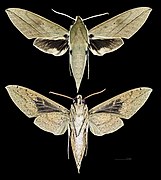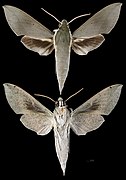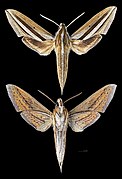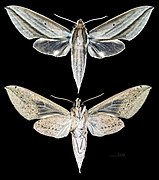Theretra
| Theretra | ||||||||||
|---|---|---|---|---|---|---|---|---|---|---|

|
||||||||||
| Systematics | ||||||||||
|
||||||||||
| Scientific name | ||||||||||
| Theretra | ||||||||||
| Huebner , 1819 |
Theretra is a genus within the butterfly family of the swarmers (Sphingidae).
features
The labial palps of the moths are softly scaled , the first segment has a hollow on the outside at the tip, which is limited by the scaling. On the inside, the scaling of the first segment is normal, similar to the genus Hippotion , but the second segment has a tuft of inwardly directed scales on the tip. The antennae are rod-shaped and long in both sexes, the last segment is short. The tibiae of the hind legs have two pairs of spurs, the inner side longer than the outer side. As with the genus Hippotion , the wings and abdomen are elongated.
The smooth eggs are usually spherical and have a green or whitish sheen.
The caterpillars look similar to those of the genus Hippotion . The head is small and rounded, the body tapers forward, the first and second abdominal segments, on which there are eye-spots , represent the widest part. The rest of the body is cylindrical. The short to medium-length anal horn is erect. The caterpillars have a longitudinal line on the sides of the body in which numerous eye spots can be found.
The pupae are also very similar to those of the genus Hippotion . The proboscis is connected to the doll's body, but is directed forward in an arc. It's keeled and flattened on the sides. There are almost always bumps behind the spiracles . The cremaster is long and pointed and has no lateral spines.
Way of life

The caterpillars feed mainly on herbaceous plants and tendrils from the families of the grapevine family (Vitaceae), arum family (Araceae), evening primrose family (Onagraceae), loosestrife (Lythraceae), redwood family (Rubiaceae) and rose apple family (Dilleniaceae).
Systematics
The genus is common in the Orientalis and Australasia . Some species also live in parts of the southern Palearctic and the Afrotropic Islands . Two types occur in Europe . The genus is very closely related to the genus Hippotion . There are currently 69 species known:
- Theretra acuta Vaglia & Liyous, 2010
- Theretra alecto (Linnaeus, 1758)
- Theretra alorica Eitschberger, 2010
- Theretra arfakmontensis Eitschberger, 2010
- Theretra baliensis Eitschberger, 2010
- Theretra boisduvalii (Bugnion, 1839)
- Theretra cajus (Cramer, 1777)
- Theretra capensis (Linnaeus, 1764)
- Theretra castanea (Moore, 1872)
- Theretra catherinae Vaglia & Kitching, 2010
- Theretra celata (Butler, 1877)
- Theretra clotho (Drury, 1773)
- Theretra detonnancourorum Haxaire, [2014]
- Theretra dominikae Melichar & Řezáč, [2014]
- Theretra floresica Eitschberger, 2010
- Theretra gala Cadiou, 1999
- Theretra gnoma (Fabricius, 1775)
- Theretra griseomarginata (Hampson, 1898)
- Theretra halimuni Eitschberger, 2010
- Theretra hausmanni Eitschberger, 2000
- Theretra improvisa Darge, 2006
- Theretra incarnata Rothschild & Jordan, 1903
- Theretra indistincta (Butler, 1877)
- Theretra inornata (Walker, 1865)
- Theretra insignis (Butler, 1882)
- Theretra insularis (Swinhoe, 1892)
- Theretra japonica (Boisduval, 1869)
- Theretra jugurtha (Boisduval, 1875)
- Theretra Kuehni Rothschild, 1900
- Theretra latreillii (WS Macleay, 1826)
- Theretra lifuensis Rothschild, 1894
- Theretra lomblenica Eitschberger, 2010
- Theretra lombokensis Eitschberger, 2010
- Theretra lycetus (Cramer, 1775)
- Theretra manilae Clark, 1922
- Theretra mansoni Clark, 1924
- Theretra maranguensis Darge, 2012
- Theretra margarita (Kirby, 1877)
- Theretra molops Jordan, 1926
- Theretra monteironis (Butler, 1882)
- Theretra mothironi Haxaire & Melichar, 2012
- Theretra muricolor Jordan, 1926
- Theretra natashae Cadiou, 1995
- Theretra nessus (Drury, 1773)
- Theretra oldenlandiae (Fabricius, 1775)
- Theretra orpheus (Herrich-Schaffer, 1854)
- Theretra pallicosta (Walker, 1856)
- Theretra pantarica Eitschberger, 2010
- Theretra perkeo Rothschild & Jordan, 1903
- Theretra polistratus Rothschild, 1904
- Theretra queenslandi (Lucas, 1891)
- Theretra radiosa Rothschild & Jordan, 1916
- Theretra rezaci Haxaire & Melichar, 2012
- Theretra rhesus (Boisduval, [1875])
- Theretra silhetensis (Walker, 1856)
- Theretra suffusa (Walker, 1856)
- Theretra sugii Cadiou, 1995
- Theretra sumatrensis (Joicey & Kaye, 1917)
- Theretra sumbaensis Eitschberger, 2010
- Theretra tabibulensis Lachlan, 2009
- Theretra tessmanni Gehlen, 1927
- Theretra tibetiana Vaglia & Haxaire, 2010
- Theretra timorensis Eitschberger, 2010
- Theretra tomasi Haxaire & Melichar, 2008
- Theretra tryoni (Miskin, 1891)
- Theretra turneri (Lucas, 1891)
- Theretra ugandae Clark, 1923
- Theretra viridis Basquin, 1992
- Theretra wetanensis Eitschberger, 2010
supporting documents
Individual evidence
- ↑ a b c d e f g Sphingidae of the Western Palaearctic. AR Pittaway, accessed April 26, 2008 .
- ↑ Theretra. Fauna Europaea, accessed April 26, 2008 .
- ^ Theretra Huebner, 1819. Sphingidae Taxonomic Inventory, accessed December 29, 2014 .





















